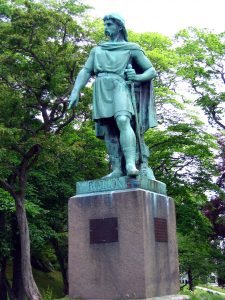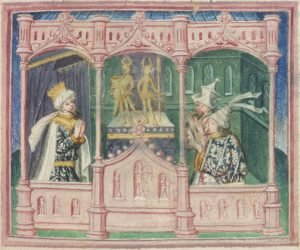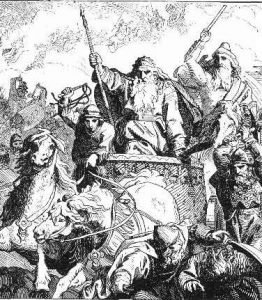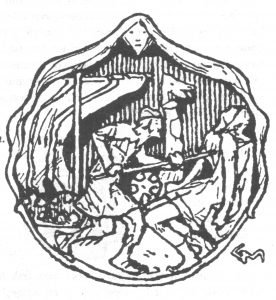“In the days of Harald Fairhair, king of Norway, certain pirates, of the family of the most vigorous prince Rögnvald, set out with a great fleet, and crossed the Solundic sea…, and subdued the islands to themselves. And being there provided with safe winter seats, they went in summer-time working tyranny upon the English, and the Scots, and sometimes also upon the Irish, so that they took under their rule, from England, Northumbria; from Scotland, Caithness; from Ireland, Dublin, and the other sea-side towns.” – Historia Norvegiae
The Loðbrók dynasty was short lived and prospered throughout the 9th Century, they are the ancestors of many famous European families including the Corbyn family.
The founder of the dynasty was Ragnar Loðbrók who was a royal exile who conquered many lands in Scotland and Ireland. He became the King of all Lochlann which was a collection of Islands north of Scotland, the Kingdom included the Orkney islands, the Isle of Mann and the Shetlands. The Kingdom of Lochlann had previously been ruled by his male line ancestor King Arthwys ap Mor. Before he became the undisputed King of Vestfold in Norway, he had an earldom in the east of Norway which was known as Møre. The name Møre alludes to the Jewish title of Mar which was carried by those who were of the Royal House of King David, of which he was one.

Around 831 after ravaging the North of England, he moved his attentions to Ireland eventually killing an Irish king and becoming a King in his own right. He first visited Ireland in 820 but by the the late 830s his intentions had changed, instead of mere conquest, now he intended to settle. This coincided with his exile by the hands of his brother Hálfdan who wanted the Kingdom of Vestfold for himself. Shortly after this, the events in fortriu of 839 in which the Picts fought a bloody battle with Ragnar and his warriors resulted in Kenneth MacAlpine’s rise to power. Saxo records that he summoned his sons Bjorn and Erik, and they ravaged the Orkney Islands, then landed at last on the territory of the Scots, and in a three-days battle wearied out their king Murial, and slew him. But Ragnar’s sons, Dunwat and Radbard, after fighting nobly, were slain by the enemy. So that the victory their father won was stained with their blood.
His crowning glory was his invasion of Paris in 845, which secured his position as the most feared man in all Christendom. His descendants continued attacking Paris throughout the rest of the century. The most famous of which was a siege in 885 led by Hrólf Rägnvaldsson who later became known as Rollo Duke of Normandie.
After Ragnar’s invasion of Paris he became very sick and word spread that he was dead, the Irish king even claimed he had killed him through drowning. His kinsman King Hrørik sent emissaries to Charles the Bald informing him that he had killed Ragnar and all his men, the truth was that Ragnar had returned to his kingdom in the Scottish isles to recover. It appears his main drive was to reconquer all the lands of his ancestors and build peaceful settlements in foreign land so that his people could prosper, evidence for this is found in Scotland during the reign of Kenneth MacAlpine who had allied with Ragnar during the 830s. In this period of recovery his kingdom in Dublin was invaded and conquered by his enemies over in Scandinavia, he sent his sons to try and reconquer these lands in Ireland, however a son called Thorir who remains unnamed in any other record was killed during one of these attempts, eventually his sons Ívar and Oláfr was successful and they became Kings of Dublin.

While Ragnar wasn’t as famous in history as he was in the sagas he was certainly worthy of honour considering he carved out a kingdom in Scotland and he paved the way for his sons to conquer the British Isles. Knowing he couldn’t do such a task on his own, he knew the only thing that could unite his children was his death. So he set out on a mission which would eventually lead to his death by the hands of King Ælla of Northumbria.

Ragnar was married at least three times in his life. His first marriage was to the shield maiden Lagertha, they married young after fighting together in the Danish civil war during the early 9th century. They had one son and three daughters Ubba/Oláfr, Aløf & Asbjørg. Ragnar & Lagertha’s relationship came to a rocky end after he met his second wife princess Thora, daughter of King Harald of Sweden. With Thora he had five sons and one daughter Agnar, Erik, Dunvat, Radbad, Thorir, and Åscrida. His third wife was Aslög and they had five sons and one daughter Bjorn, Halfdan, Sigurd, Rögnvald, Ivar and Thora. There is also another known son called Ásl, Óláfr killed him in 867 but the histories fall silent as to the true reason for his murder. Thorir son of the King of Lochlann, heir to Ragnar’s kingdom in Ubba’s absence was killed in 848 during an attempt by King Ragnar to reconquer his lands in Ireland, which had recently been taken over by his enemies. An illegitimate daughter Matilda married Godfrid son of Harald Klak, Godfrid claimed the duchy of Frisia after Ubba’s death in 877.
The Loðbrók Dynasty sadly ended with the death of his children, however his son Bjorn Ironside seeded the Münso dynasty in Sweden, his son Ivar seeded the ua Ímair dynasty in Ireland, his son Rägnvald seeded the House of Normandy, while his son Sigurd seeded the House of Gorm in Denmark.
Ragnar Loðbrók m. Hlaðgerðr, the shield maiden
- Óláfr/Amlaíb/Ubba, the King of Dublin.
- Aløf married Helgi the Sharpe.
- Asbjørg married Æthelwulf, King of Wessex, mother of King Alfred the Great .
Ragnar Loðbrók m. Thora the Townhart, Princess of Sweden
- Agnar killed in the battle for Sweden.
- Eirik (Hrørek/Roric) killed in the battle for Sweden.
- Dunvat Killed in the conquest of Lochlann.
- Radbad (Rodbert/Radbard/Redbeard) killed in the conquest of Lochlann.
- Thorir killed in an attempt to reconquer Dublin.
Ragnar Loðbrók married Aslög, princess of Sweden
- Halfdan “Whiteshirt” via his daughters he seeded the Rurik dynasty of Rus.
- Sigurd “Snake In The Eye” seeded the house of Gorm that ruled Denmark.
- Ivar “The Boneless” seeded the Ua Imair dynasty that ruled Dublin.
- Rögnvald “The Wise” seeded the Dukes of Normandie.
- Thora who married Gerulf, Count of Frisia.
- Bjorn “Ironside” seeded the Münso dynasty that ruled Sweden.




You must be logged in to post a comment.